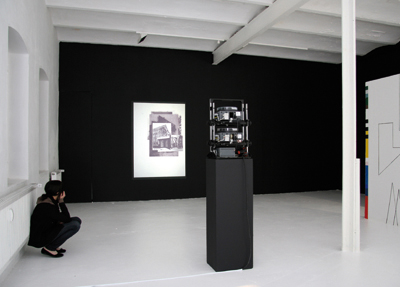
Installation View, Halle für Kunst, Lüneburg
The Piece “When I Walk on the Streets these Days, somehow I can‘t relax…” is a slide projection and two wall paintings. The slide projection shows the cross-fading images of a pile of papers, one sheet after another is taken away and reveals the next image. The papers show black and white images of facades, some sheets with text and some with drawings of elements of the house fronts in the photographs. The facades are examples of barracks decorated by artists in Tokyo after the Great Kanto Earthquake.
On September 1. 1923 Tokyo and Yokohama were hit by an earthquake estimated to have had a magnitude between 7.9 and 8.4 on the Richter scale. The Quake and the following fires resulted in the destruction of 80 percent of the mainly wooden buildings in Tokyo, with around 100.000 dead and about 1.9 million people homeless. Earthquakes happens regularly on the Japanese Archipelago, which is mirrored in the architecture and layout of the cities, but this one came to be one of the major seizures in the history of the city and marks a particular moment of a city in transition into modernity.
In the days and weeks after the earthquake, reconstruction of the city began and very soon temporary structures for living and commercial purposes were constructed in all the affected areas, known as barracks or in Japanese “barakku”.
In the year leading up to this event, groups of artists and designers had emerged, contesting the traditional Japanese art as well as the imported academic western style painting. They were well connected and informed about international movements such as Dada, Bauhaus and de Stijl, but also about Bruno Tauts work as town councillor of architecture in Magdeburg and his ideas about the coloured city.
The situation of tabula rasa and complete urban chaos after the earthquake was seen by many artist as a unique possibility to rebuild the city, and to take art “from the atelier to the street”. Artists and designers formed in groups and companies with the purpose of decorating the facades and sometime the entire barracks and their interiors, the most well known being The Barrack Decoration Company, Forefront and Mavo. They offered their services to the owners of the new, temporary structures, typically restaurants and shops, and produced a series of full scale designs and paintings on the facades of the houses in the months after the earthquake, believing in a new kind of art closely related to the urban everyday life. This practice lasted only a few months after the quake, and thereafter disappeared, today only some of this work is known through black and white photographs and descriptions by contemporary witnesses.
In the form of the slide projection and two wall paintings “When I Walk on the Streets these Days, somehow I can‘t relax…” analyses these façades and the photographs representing them, it investigates a moment of architecture and design after urban disaster. It looks at the temporality of Japanese architecture, on the performativity of the façade as an urban stage set and as a carrier of something that at this moment was a radical, modern gesture. The title is a quote of a contemporary critic.
The projection is divided in a prologue and 3 chapters. It develops around the black and white photographs of the barrakku and the partial information they offer. It looks at the black and white photograph as a carrier of information, at the photocopy and the printed reproduction as a medium at once giving access and assuring distance to its subject at once. The images in the slide projection are ephemeral and temporary, and disappear just as soon at they light up on the screen.
The first chapter contains the photocopies themselves. The second chapter contextualizes the images by presenting a rereading of a recent text about the movement, „Designing after Disaster“ by Genifer Weisenfeld, a scholar in on the field. The third chapter consists of drawings based on the photographs. The drawings reconstruct the facades and analyse the elements of the composition in order let them disolve in the simple animation of the crossfading slides.
The wall paintings are based on the elements in a design for a facade by the Japanese architect and painter Kato Masao, a documentation of which also appears in the prologue of the slide projection. He exhibited model of this design in June 1923, some months before the Earthquake. Later he was not directly involved in the Barrack decorations, however well acquainted with the main protagonists of this movement.
Wandmalerei
Halle für Kunst
Lüneburg
20.10. - 2.12.2007